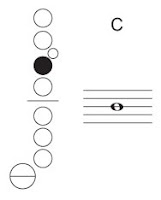| Playing | Fingering Chart | Finger Placement |
| B |  | The common first note on any woodwind is a B, which is fingered by pressing down the first finger of the left hand on B key. Practice long tones on this note. |
| A |  | Pressing down the first and second finger of the left hand (note that the "little button" is skipped and the second finger goes on the larger button below it). Practice long tones on this note, then practice moving between B and A. |
| G |  | A G is fingered by pressing down the first, second, and third fingers of the left hand. Practice long tones, moving between B, A, and G in all combinations. |
| C |  | To play a C, finger an A and remove the first finger. Again, practice long tones and moving between all of the notes you know. |
| D |  | This is a tricky note on saxophone. To play a D, hold down the octave key (which is just above your thumb on your left hand) and push down the first three fingers of your left hand and the first three of your right hand. The note will probably not come out on the first try. Keep trying until it works. It takes a more focused air stream. Once you can consistently get the D out, practice long tones and moving from C to D. This is a fairly difficult jump. |
| E |  | Once you have mastered the D, the E should be simple. Hold the octave key and finger a D, lifting the third finger of the right hand. The same type of air stream is required. Again, practice long tones and moving to E from the other notes. |
| F |  | To play an F, hold the octave key and finger an E, removing the second finger on the right hand. Again, the air stream should be focused. Practice long tones and moving between all of the notes. |






